In years past I didn’t always take advantage of photo ops with American White Pelicans.
After all, they’re often not doing much of anything interesting, spending much of their time floating lazily on the water or basking on the shore and when they’re in flight they’re often gliding, which typically doesn’t provide much in the way of interesting wing positions. How many photos do I need of pelicans in flight with plain blue sky in the background?
But this year is different. When I see pelicans I nearly always scope them out with my lens and I usually take at least some photos to document the occasion. Following are five of my recent pelican photos.
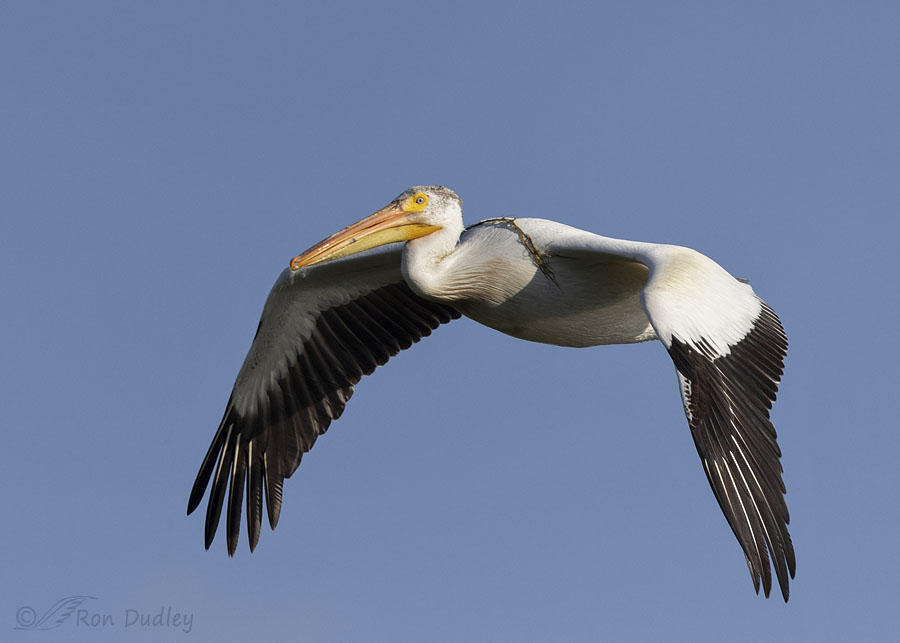
This one had aquatic vegetation draped across its upper back. I didn’t even notice it until I looked at my photos at home. Not long ago I posted another photo of this bird but this one is new to Feathered Photography.
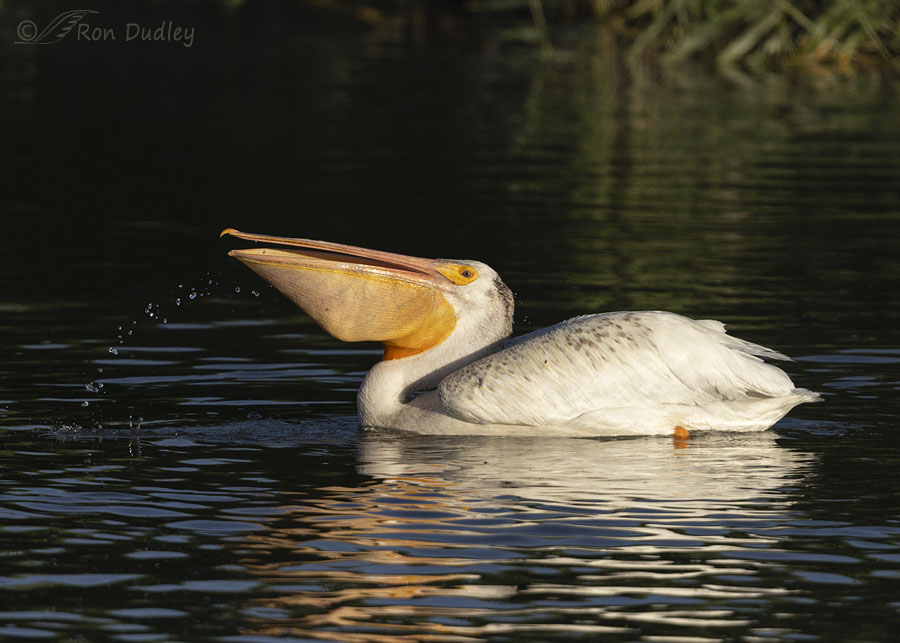
This pelican is about to swallow something it had just caught, probably one or more small fish.
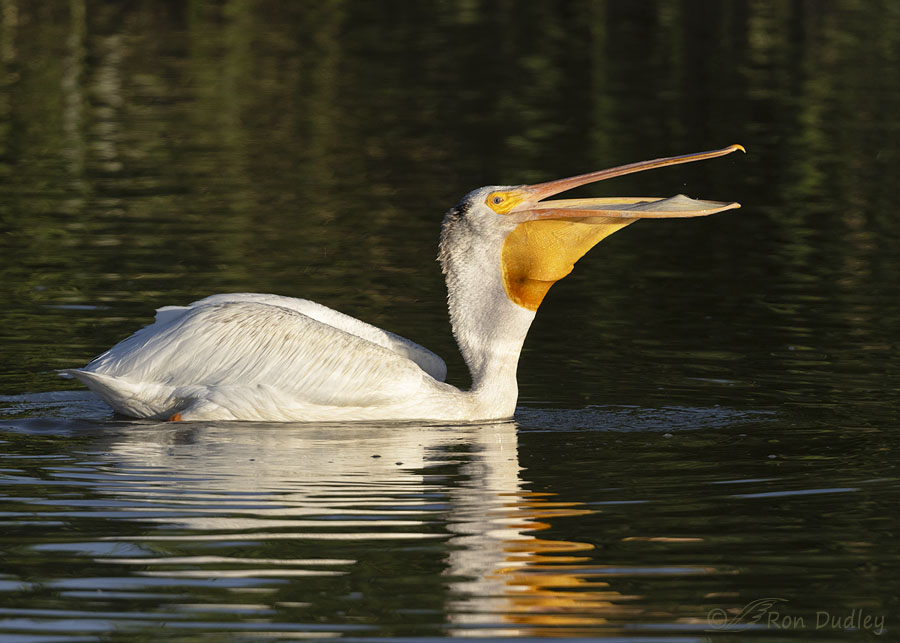
Another one, swallowing its catch. If I can get the exposure right, I’m a sucker for white birds against dark backgrounds.
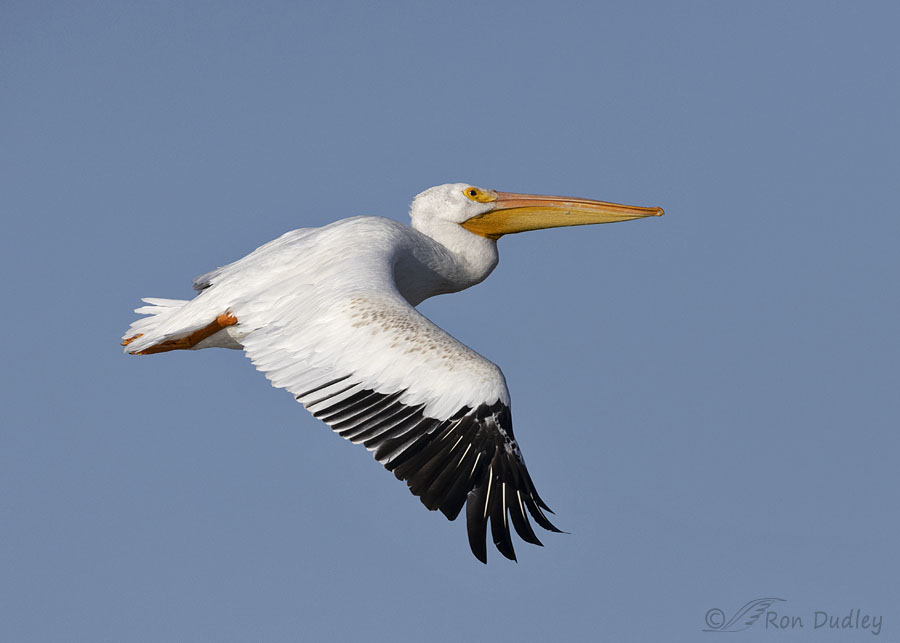
I’m less fond of plain blue skies as backgrounds but at least the pelican isn’t just gliding.
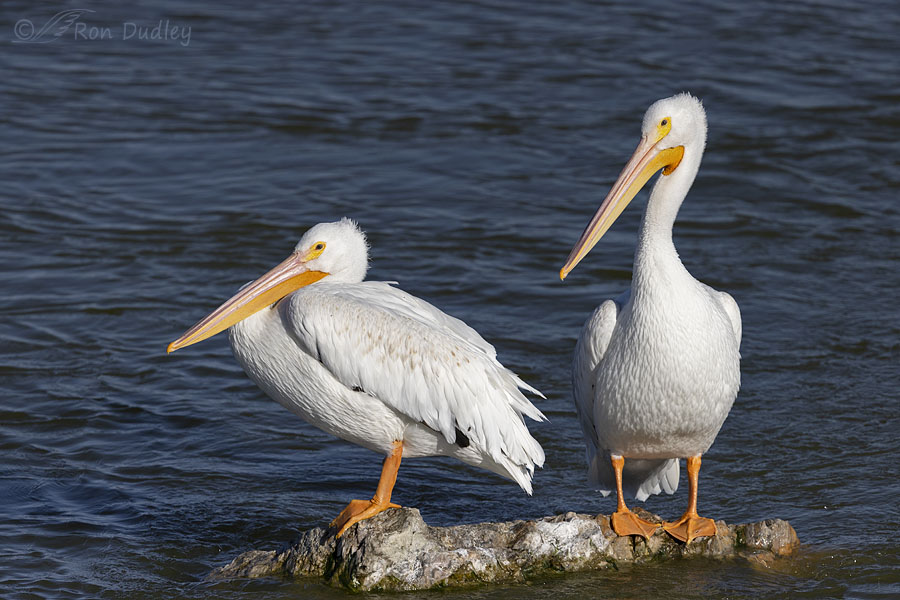
Even though it’s a little tight I quite like this photo, taken two days ago along the causeway to Antelope Island. For me, getting two pelicans out of the water, on an interesting perch and in contrasting poses, doesn’t happen every day. Especially when both very large birds are sharp.
I’m taking more pelican photos than usual because after this year I may not have many chances with them.
Great Salt Lake’s Gunnison Island is one of the top two or three breeding sites of American White Pelicans in North America. As many as 20,000 breeding pelicans nest on the island because, as an island, it’s always been protected from predators, scavengers and human disturbance.
At this point I suggest that you open this link to a high-quality aerial photo of pelicans nesting on Gunnison Island. Each small white dot you see on the shore and further up the cove is a nesting pelican (or two).
But this year, because of the disappearing Great Salt Lake, Gunnison Island is no longer an island. It’s connected to the mainland by land bridges which have allowed predators like coyotes and foxes, and even some law-breaking humans, access to the former “island”. As a result, pelicans have completely abandoned the island as a nesting site. This year not a single pair of pelicans nested on Gunnison Island.
We can only guess what will happen next year. Will the pelicans go two years in a row without nesting? Or will they even come back, preferring to take their chances elsewhere?
So that’s why I’m photographing pelicans more often than usual. Largely because Utah refuses to control its lustful gluttony for water.
Ron
PS – If you’re interested, here’s a couple of links providing more info.
- Thousands of nesting birds have vanished at Great Salt Lake’s Gunnison Island
- Drastic decline in American White Pelicans at Great Salt Lake raises concerns


Catching up on my FP. Been traveling to the San Francisco bay area and Morro Bay.
Love pelicans. They are one of the most unlikely creatures you would expect to be such master flyers and hunters; just so beautifully whimsical yet masterful. They remind me of the huge flying boats that were once the mode of air travel in the early/mid 1900s.
Saw many American White Pelicans in the tidal lands of the San Pablo Bay National Wildlife Refuge. Reading your post gave me pause to wonder about the fate of these magnificent birds.
In Morro Bay, where American White Pelicans can be seen, the sky was full of Brown Pelicans. I stood on the beach looking up with admiration, thankfulness, and wonder. When I was in high school in 1970, the Brown Pelican was declared endangered. Then, in 1972, the EPA banned the use of DDT in the United States. Now their status is listed as Least Concern.
We are capable of course corrections. Let us aim for that.
Beautiful photos, Ron. That is terrible news about the loss of the pelican nesting area.
Your photos are so beautiful. Thank you . The text is heart breaking.
I am not very hopeful.
Take Care,
Kaye
Thanks, Kaye. I’m afraid I’m not either.
When a colony in North Dakota collapsed in 2005, expanded in the upper Midwest. We now have some 4,000 nesting pairs on Cat Island in the bay of Green Bay plus others at the Horican Marsh and an inland lake system. All season long they can be found flying overhead, fishing in the Fox River…a 10 minute drive for me. I see them in a few nature reserves along the bay..just a joy to watch their fishing techniques. It’s hard to imagine losing this gift of nature.
On a side note, even though I haven’t commented for a few years, I’ve read your blog frequently doing so perhaps in two week segments. Two knee replacements and other issues surprisingly changed my daily routine. Sometimes life interfere in ways we don’t like…
Glad to know you’re still out there, Kathy. I get that about health issues changing our routines.
I adore pelicans. And no, that is not too strong a word. As I read through your post and marvelled at the photos expletives at our greedy and self centred species were my first words of the day.
“expletives at our greedy and self centered species were my first words of the day.”
And appropriate expletives they were, EC. I’m glad you have an expanded vocabulary in that department for situations like this.
The title of your post shows up in my email line – from that, I was afraid you were going to be discussing something dreadful like this.
From 20K breeding pairs to 0, though, is even wore than I imagined.
They are very odd looking birds. Were these at Bear River MBR?
A couple of years ago we were at Bosque del Apache in late October, and a huge flock of Pelicans flew over, heading south. They were in a line which seemed to stretch across the whole sky, all with wings extended, just gliding along. Totally awe-inspiring. Quick, grab your camera, to show what once was 😢
“Were these at Bear River MBR?”
Carolyn, all of these photos except the last one were taken at Bear River. That’s where most of them go daily to feed. The refuge has fish because it’s fresh water – there are no fish in the lake itself. It’s too salty.
Love the White Pelicans — especially the one with the “veggie boa” and Fred & Barney on the rocks (sorry, had to go for the Flintstones reference).
Furious and frustrated with the people — both your legislature for letting things get so bad as well as the arse-holes who invade the (former) island and those who keep voting the idiots into office.
Marty, “voting the idiots into office” is a huge part of the problem. That and too many idiots to do it.
I just echo the same sentiment as all of you about our loss of grounds for many of our species of wildlife. Not wanting to add to a solemn tone, Ron I think your weakness for dark backgrounds has been a complimentary choice in two of your shots. The feathers of these birds are almost visibly patternless yet you’ve been able to provide a beautiful contrast in those two photos by using reflected water ripples and the side rock pattern near the edges shoreline. Thank you for taking up your newest interest in capturing as many pix as you can. I share your weakness for dark backgrounds, here water reflections help to promote a complimentary pattern against these beautiful bright birds. Bravo, please continue as often as you can….. and then share with us, please.
Thanks, Deb. Shooting in early morning light helps a lot with getting detail in those whites. And I’m nearly always shooting in the early morning.
Great seriess. thanks for sharing!
Charlotte Norton
1
Thanks.
I love Pelicans. The way the glide mere inches above the water is amazing.
I agree.
Sadness…..sadness….a sense of such loss coming, every day. I’m
glad that at least photographers such as you can document what the
world is losing, almost by the day……
It’s depressing isn’t it, Kris.
Keep taking those outstanding Pelican photos. If you see a Red tagged N09 that’s a guy who lived here year round for 5 years, but has disappeared. My friend Steve and I have reported Idaho Red-tagged and Gunnison Green-tagged Pelicans we have had here and in doing so have received thank you certificates from both places.
Your post is very interesting because neither Steve nor I are aware that they are no longer breeding at Gunnison.
We named our N09 guy Ted Williams due to the #9 that old baseball fans like me will always associate with our last .400 hitter.
Excellent photos.
Everett, I’ll keep my eyes peeled for “Ted”.
Interestingly, the last few nights I’ve been watching Ken Burns’ excellent documentary, “Baseball”, for at least the second time. And last night’s episode featured Ted Williams, among other great players of his era.
Fun and beautiful – glad you noted it was vegetation as it almost looked like barbed wire to me! Critters always “pay” for human gluttony 🙁 Where would 20,000 birds go when their nesting site becomes unworkable? Their “pouch” for holding captured food is facinating to me both for it’s size and elasticity…… 🙂
“Where would 20,000 birds go when their nesting site becomes unworkable?”
Good question, Judy. Or would they even nest at all.
Everything dries up due to human exploitation! There will be less for future generations! So sad!
Karl, as a species we’re not very smart. Self-destructive is more accurate.